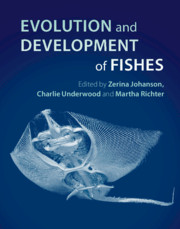Book contents
- Evolution and Development of Fishes
- Evolution and Development of Fishes
- Copyright page
- Contents
- Contributors
- Introduction
- 1 The Evolution of Fishes through Geological Time
- 2 Comparative Development of Cyclostomes
- 3 The Ordovician Enigma
- 4 The Evolution of Vertebrate Dermal Jaw Bones in the Light of Maxillate Placoderms
- 5 Doliodus and Pucapampellids
- 6 The Evolution of Endoskeletal Mineralisation in Chondrichthyan Fish
- 7 Plasticity and Variation of Skeletal Cells and Tissues and the Evolutionary Development of Actinopterygian Fishes
- 8 Origin, Development and Evolution of the Fish Skull
- 9 Evolution, Development and Regeneration of Fish Dentitions
- 10 Development of Head Muscles in Fishes and Notes on Phylogeny-Ontogeny Links
- 11 Evolutionary Development of the Postcranial and Appendicular Skeleton in Fishes
- 12 Evolution of Vertebrate Reproduction
- 13 Links between Thyroid Hormone Alterations and Developmental Changes in the Evolution of the Weberian Apparatus
- 14 Pharyngeal Remodelling in Vertebrate Evolution
- 15 Evolution of Air Breathing and Lung Distribution among Fossil Fishes
- Index
- References
3 - The Ordovician Enigma
Fish, First Appearances and Phylogenetic Controversies
Published online by Cambridge University Press: 31 December 2018
- Evolution and Development of Fishes
- Evolution and Development of Fishes
- Copyright page
- Contents
- Contributors
- Introduction
- 1 The Evolution of Fishes through Geological Time
- 2 Comparative Development of Cyclostomes
- 3 The Ordovician Enigma
- 4 The Evolution of Vertebrate Dermal Jaw Bones in the Light of Maxillate Placoderms
- 5 Doliodus and Pucapampellids
- 6 The Evolution of Endoskeletal Mineralisation in Chondrichthyan Fish
- 7 Plasticity and Variation of Skeletal Cells and Tissues and the Evolutionary Development of Actinopterygian Fishes
- 8 Origin, Development and Evolution of the Fish Skull
- 9 Evolution, Development and Regeneration of Fish Dentitions
- 10 Development of Head Muscles in Fishes and Notes on Phylogeny-Ontogeny Links
- 11 Evolutionary Development of the Postcranial and Appendicular Skeleton in Fishes
- 12 Evolution of Vertebrate Reproduction
- 13 Links between Thyroid Hormone Alterations and Developmental Changes in the Evolution of the Weberian Apparatus
- 14 Pharyngeal Remodelling in Vertebrate Evolution
- 15 Evolution of Air Breathing and Lung Distribution among Fossil Fishes
- Index
- References
Summary
The Ordovician history of fish is limited by a combination of biological, environmental and taphonomic constraints but appears to contain significant milestones referencing the first appearances of a number of major groups, including putative jawed fish. In addition, the depositional settings from which fish are recovered are restricted to a narrow range of environments, and, similarly, the stratigraphic coverage remains patchy despite increases in reporting over recent years. The Gondwanan and Laurentian record further diminishes with the onset of the end-Ordovician glaciation and concomitant extinction event, a pattern which continues into ‘Talimaa’s Gap’ at the base of the Silurian. Phylogenetically, many of the Ordovician taxa are problematic to place in the higher taxonomic groupings that dominate the Siluro-Devonian. With caution, a number of the scale-based taxa fall within the crown-gnathostomes, re-emphasizing the importance of the Great Ordovician Biodiversification Event in setting the scene for subsequent vertebrate evolutionary radiations and range expansions.
- Type
- Chapter
- Information
- Evolution and Development of Fishes , pp. 59 - 70Publisher: Cambridge University PressPrint publication year: 2019
References
- 4
- Cited by

